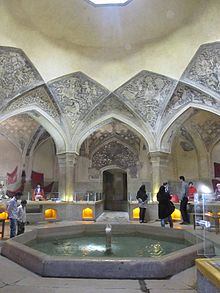Lime soap
| Lime soaps of individual fatty acids, e.g. B. calcium salts |
| Calcium oleate, the calcium salt of oleic acid . |
| Calcium palmitate, the calcium salt of palmitic acid . |
| Calcium stearate , the calcium salt of stearic acid . |
Lime soaps are calcium or magnesium salts that are sparingly soluble in water , usually of fatty acids .
They form when using soaps in hard water . The formation of these lime soaps reduces the washing effect, as the active amount of soap is reduced. The lime soaps settle on surfaces (graying) and form gray deposits that are difficult to remove even in sewer pipes . The formation of lime soaps can be counteracted with softeners that bind calcium and magnesium ions.
The cleaning agents mainly used in households today contain little or no soap, but other active washing substances ( surfactants ). These form little or no lime soaps, do not lead to graying and retain their washing effect in hard water even without a softener. In return, they degrease the skin much more, which means that it dries out quickly, and make it permeable to, for example, existing preservatives, dyes and fragrances.
Lime soaps can appear as an undesirable contaminant in oils intended for cosmetic and food industry applications. They are detected there qualitatively analytically, for example with phenolphthalein solution, which turns red when lime soaps are present.
use
The water-repellent ( hydrophobicity ) property of lime soap is used, for example, in Tadelakt , a Moroccan plastering technique, or in Opus signinum , an ancient Roman plastering technique. The formation of small amounts of lime soaps is used in modern detergents to avoid excessive foam development. In the EU , they are generally approved as food additives under the numbers E 470a (the calcium salts of fatty acids, in addition to the sodium and potassium salts also included) and E 470b (magnesium salt of fatty acids) without maximum quantity restriction ( quantum satis ) for food in general. They are used in food technology as emulsifiers , stabilizers , release agents , coating agents or as carrier substances for other additives and flavors and can be found in baked goods and confectionery, among other things. The raw materials can be obtained from genetically modified plants, which is usually not declared in the end product.
Lime soaps are also used in the manufacture of cosmetic products, calcium stearate and other lime soaps are also used as water-repellent lubricants for Staufferfett .
literature
- Siegfried Hauptmann : Organic Chemistry . New edition. Deutscher Verlag für Grundstofftindustrie, Leipzig 2001, ISBN 3-342-00635-8 (reprint of the Leipzig 1991 edition).
- Hans-Georg Henning, Werner Jugelt, Günther Sauer: Practical chemistry. A study book for physicians and scientists . 5th edition. Verlag Deutsch, Thun 1991, ISBN 3-8171-1139-8 (reprint of the Berlin 1982 edition).
- Hugo Janistyn: Pocket Book of Modern Perfumery and Cosmetics . 4th edition. Wissenschaftliche Verlagsgesellschaft, Stuttgart 1974, ISBN 3-8047-0473-5 .
- Hermann Pardun : Analysis of dietary fats (basics and advances in food analysis and food technology; 16). Parey, Berlin 1976, ISBN 3-489-78814-1 (complete revision by Werner Wachs: "Oils and Fats - Analysis of Dietary Fats" ).
Individual evidence
- ↑ Hauptmann: 1985, page 740.
- ↑ transGEN: Fettsäuren E 570 ( Memento from February 12, 2012 in the Internet Archive ).




